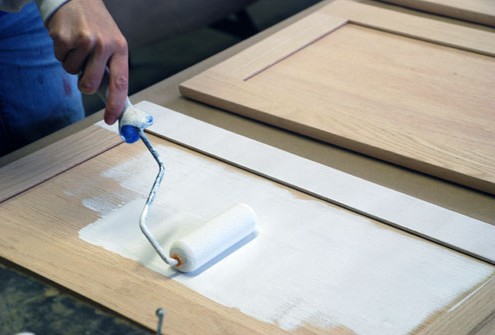Priming…yeah it’s that important.
Priming…Most people hate it. Why? They think it’s extra work. I’m here to tell you it’s not, and your finished product will turn out much better with its use.
I used to be a manager at a certain big retail giant…let’s call them “Glowe’s.” One busy Saturday at Glowe’s I was stopped in the lumber department by a customer with a question. The gentleman and his wife were looking at T-1-11 siding. That’s the siding with grooves every 4-6″ inches. You see it now mainly on sheds and storage buildings. It’s made from plywood, and is usually pretty good stuff.
The man stopped me and asked if it “had to be primed.” I told him, “No; but if you want the paint to stick well, the wood not to warp and rot, and the project to last, then Yes.” He did not like my answer. I wanted to tell him a simple Yes, but that would be untrue. You can “get away” with not priming just about anything, and most new paints will kinda stick. However, I only suggest this if you like sub-par quality finishes and re-doing things.
Why don’t paint companies just make a good paint that both primes and paints? Good question. Actually Behr has just recently released its new Premium Plus Ultra Primer & Paint In-One. Supposedly, it cuts your painting time in half by eliminating the priming and drying stage. Does it work? I don’t know; I’ve never used it. But I’ll be sure to write a review as soon as I do.
Primer serves a couple of functions. Without getting all “techy”, here we go:
1. It’s a sealer. Primer goes on easy, and dries fast. When it seals the material’s surface, it helps the paint soak in more evenly. This means your color will be more uniform with hardly any blotchy spots. It also means less paint is needed to achieve the same look (because less paint is soaked up).
2. It sticks to just about anything. Although paints have come a long way in the past decade, they still can’t beat primer. Anyone who has painted anything and used primer knows how hard it is to get it off your hands. That’s because primer is formulated to stick, period. This gription (yes I made that word up) means your coat of primer will ensure a good bond between your paint and surface.
3. It’s a stain blocker. Have you ever had a water spot on drywall? A couple quick coats of a good quality primer followed by paint, (assuming the water penetration was not severe) and you’ll never see that nasty old spot again. Try that with just paint and you’ll pull your hair out trying to rid yourself of the spot.
When it comes to primering wood, take heed of my advice. All sides of the surface must be covered! This is due to the fact that wood is constantly moving. As it absorbs moisture, the fibers in the wood will move, swell and shrink. If only one part of the board is primered, that part of the board will be “sealed” and absorb less moisture, and therefore swell or shink less. The rest of the board that is not primered will absorb more moisture than the primered side and will swell or shrink at a more dramatic rate. When this happens, you end up with warped or twisted wooden boards.
Primering all sides of wood also helps stop rot. A fully primered board will “reject” moisture and really slow down the rotting process. Even wood trim used today that will be wrapped in metal or vinyl needs to be primered and sealed before it is wrapped. Does this happen? Not very often.
Some people only use one coat of primer when painting. Sometimes that’s all you need. Sometimes it’s not. Here’s my personal rule: If you can tell what color the surface is under the primer coat, you need more primer.” Embrace the primer. Give it love. It’ll pay you back tenfold…
I think I going to patent the word gription…


